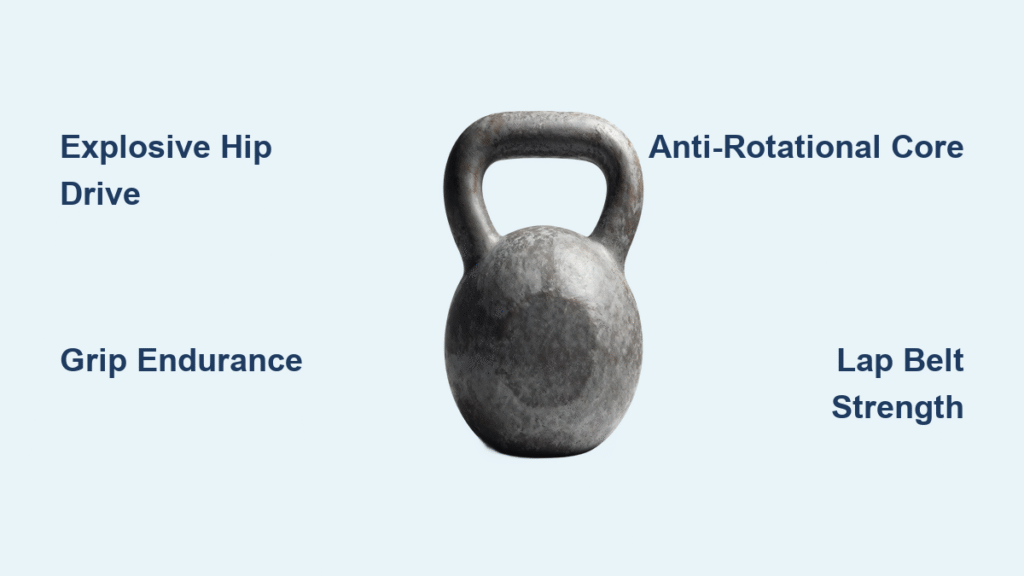Your guard finally collapses under pressure. Your hips feel sluggish during a critical scramble. That perfect sweep you drilled 100 times vanishes when adrenaline hits. These aren’t just technique failures—they’re strength gaps that Brazilian Jiu-Jitsu alone can’t fill. Kettlebell training bridges this divide with surgical precision, building the explosive hip power, ironclad grip endurance, and rotational core strength that decide matches. Three focused 20-minute sessions weekly develop mat-specific strength without draining energy for technical practice. This guide delivers the exact kettlebell exercises proven to boost guard retention, takedown explosions, and scramble endurance for BJJ athletes.
Why Kettlebells Dominate BJJ Conditioning
BJJ demands unique physical qualities your regular training misses. Your joints absorb violent, uneven loads during sleeve grips and guard passes while generating power from compromised positions. Traditional gym work often ignores these demands, creating exploitable weaknesses. The kettlebell’s offset center of mass perfectly replicates the chaotic forces you face on the mat—gripping collars, fighting underhooks, or resisting sweeps. This single tool builds three critical BJJ attributes simultaneously: explosive hip drive for guard passing, grip endurance for prolonged control, and anti-rotational core power to maintain posture. Crucially, anti-glycolytic protocols prevent excessive soreness so you arrive fresh for every roll.
Essential Kettlebell Movements for BJJ Dominance

Swing: Your Guard-Passing Power Generator
The kettlebell swing builds explosive hip extension—the exact motion needed for explosive guard passes and takedowns. Focus on driving your hips forward (not upward) while letting your arms act as cables. For BJJ carryover, master one-arm swings to develop anti-rotational core strength that mirrors resisting an opponent’s off-balancing attempts. Start with 5 two-arm swings EMOM (every minute on the minute) for 4 weeks. Then progress to 5 one-arm swings EMOM, switching arms each minute. Your breakthrough milestone: completing 200 one-arm swings in 20 minutes before increasing weight. Breathe with two quick nasal sniffs on the downswing and a power exhale on the hip drive—this pattern directly transfers to explosive bridging.
Turkish Get-Up: Tactical Stand-Up Strength Builder
This movement replicates the exact motor pattern for rising from guard while bulletproofing shoulders against kimuras. Perform TGUs in three load zones per session: light bells for exaggerated pauses and rotations, medium bells for perfect full singles, and heavy bells for partial reps (to elbow or tall sit) without setting the bell down. Beginners should spend ≤15 minutes alternating sides; intermediates target 30 minutes. The time-under-tension builds “in-between” strength for bridging and posting when your opponent fights your pass. Key cue: Use “Darth Vader” breathing between sides—deep diaphragmatic breaths accelerate recovery like catching your breath mid-roll.
One-Arm Thruster: Full-Body Power Transfer Drill

Combine squat drive with overhead stability to mimic controlling an opponent’s lapel while base-posting. Hold a single kettlebell in front rack position, then explosively squat and push-press overhead. For power development, use heavy weight for 3-5 reps. For conditioning circuits, go lighter for 10-20 reps. This movement directly trains unilateral overhead stability—critical when posting on a sleeve with one hand while your base shifts. Always prioritize perfect form; technical flaws amplify under fatigue, just like during scrambles.
Cossack Squat: Lapel-Passing Groin Strengthener
This wide-stance movement builds the hip adductor endurance essential for knee-cut passes and long guard retention. Start bodyweight until you achieve full range, then progress to holding a kettlebell in front rack position. Perform 5-10 reps per side shifting weight laterally while keeping the opposite leg straight. The lateral hip strength developed directly improves your toreando passes and resists being flattened in guard. Unlike traditional squats, Cossacks target the groin muscles that get shredded during extended guard play.
Programming Templates for Rapid Mat Results

3-Day Minimalist Program (45 Minutes Weekly)
Tuesday – Heavy Day
Goblet squat warm-up (3×3-5 reps), then 5 one-arm swings EMOM progressing to 5 every 30 seconds. Finish with 30-40 minutes of Turkish Get-Ups using three bell sizes.
Thursday – Medium Day
Repeat Tuesday’s movements at 80% volume focusing on perfect technique over load.
Sunday – Light Day
Speed-focused two-arm swings (5 EMOM) and lighter TGU work with extended pauses. Add farmer carries (30 meters) for grip resilience.
Beginner Circuit (20 Minutes)
Complete 3 rounds:
– Goblet squat: 5 reps (builds shrimping strength)
– Two-arm swing: 15 reps (hip explosion foundation)
– Half Turkish Get-Up: 2 reps/side (tactical stand-up prep)
– Russian twist: 20 total (rotational core for sweeps)
– Farmer carry: 30 meters (grip endurance for sleeve control)
Loading Guidelines to Avoid Plateaus
Start with these baseline weights:
– Male beginners: 20-35 lb (9-16 kg)
– Female beginners: 15-26 lb (7-12 kg)
Progress only when you:
– Complete 200 one-arm swings in 20 minutes
– Maintain perfect TGU form under “talk test” conditions (able to speak full sentences)
– Execute all prescribed reps without technical breakdown
Critical rule: Always increase training density (time or reps) before adding weight. Cycling intensity across heavy/medium/light days prevents CNS fatigue that would sabotage mat performance. Upgrade bells only after mastering current load—this preserves joint health during high-volume BJJ training.
BJJ-Specific Breathing Integration
Your kettlebell breathing must mirror mat demands. During swings, use fractional breathing: two quick nasal sniffs on the downswing, power exhale on the upswing. This replicates explosive hip drives during guard passes. For TGUs, inhale during transitions and use a three-count exhale during pauses—this builds tension control for bridging sequences. Post-workout, practice 4-8 hypercapnic breathing (4-count nasal inhale, 8-count mouth exhale) during cooldown stretches. This accelerates recovery between rolls by 20-30%, letting you train harder with less fatigue.
Injury Prevention Through BJJ-Specific Prehab
Every kettlebell exercise doubles as prehab. Turkish Get-Ups bulletproof shoulders through multi-planar stability, reducing kimura vulnerability. Goblet squats counter guard-play hip tightness by reinforcing knee tracking and full-depth mobility. Farmer carries simultaneously strengthen grip endurance and rotator cuff resilience—critical for enduring prolonged sleeve grips. Add weekly maintenance: Russian hockey deadlifts (3×10/side) decompress your spine after rolling, while accumulating 2-3 minutes of long hangs builds shoulder capsule robustness. These movements prioritize function over muscle isolation, reinforcing the exact mobility needed for high-level BJJ.
Common Questions BJJ Athletes Ask
Q: How often should I train kettlebells with BJJ?
A: Three 20-30 minute sessions weekly. These complement—not replace—technical training without adding glycolytic fatigue.
Q: Do kettlebells make you too sore for training?
A: Anti-glycolytic protocols (like EMOM swings) avoid excessive soreness. The talk test ensures you’re building capacity, not crushing your CNS.
Q: Kettlebells vs. dumbbells for BJJ?
A: Kettlebells replicate BJJ’s uneven loads through offset center of mass. Only kettlebells build grip endurance during ballistic swings and simulate lapel control in front rack positions.
Next Steps for Immediate Mat Impact
Start today with the beginner circuit—master goblet squats and two-arm swings before progressing. Film your form; mobility restrictions revealed during kettlebell work directly limit your BJJ performance. Your first milestone: complete 100 two-arm swings in 10 minutes with perfect hip hinge mechanics. This baseline translates directly to stronger frames and explosive bridges. Within six weeks, you’ll feel unbreakable grips during long rolls and guard passes that explode with new power. The kettlebell isn’t just gym equipment—it’s the missing link between your technique and physical dominance. Three short weekly sessions build the specific strength BJJ can’t develop alone, transforming you from a technician into a dominant force on the mats.




